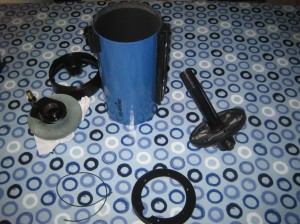I’ve been doing a fair bit of fiddling around with my 127 Mak recently. The initial reason for this was that the mirror had become loose on the carrier mechanism, meaning lots of trouble getting reliable focus.
To fix this it was necessary to remove the corrector lens from the front of the OTA, remove the focuser knob and slide the entire mirror assembly off the baffle tube whilst fiddling the focuser spindle through the backplate and trying not to get grease everywhere. The mirror carrier itself is an externally threaded tube with a flange against which the front of the mirror rests. Behind the mirror is an o-ring. The focuser plate screws onto the thread behind that to hold the mirror in place and behind the focuser plate is a locknut which, in theory at least, should keep the whole lot fixed in place.
Having taken the scope apart it was going to be necessary to collimate it once reassembled. I don’t have a proper collimation cap, so I made one up out of the nasty 2x barlow shipped with some Skywatcher scopes (from which I have already removed the lens so I can use it as an extension tube). I then found a plastic bottle top that would fit over the end neatly and drilled a 3mm hole through the middle. This went into the back of the baffle tube and I started to follow the instructions here:
(Should this link break and the file isn’t available elsewhere, I have a copy of it.)
It’s actually somewhat more tricky than might be suggested given that effectively all six screws (three “pull” and three “push”) need to be adjusted at the same time to move the backplate, thus moving the baffle and the mirror. I found it helped to move to the front of the scope and stand at the focal distance. By lining up the reflections it was then much easier to tell if I was out and by how much. The rings formed by all the reflections are fairly obviously skewed if it is out of collimation.
Over half an hour or so of tweaking the adjustments I got it as close as I felt was possible without a star test (and I don’t at the moment have an artificial star). A final check through the colli cap to make sure that looked ok and, oh, now that’s not good. The mirror appeared to be collimated properly, but the baffle tube was clearly not central and I could see more on one side of the secondary mirror than the other.
It’s worth noting at this juncture that I didn’t buy the Mak new, and when I did it came with an SCT adapter and two inch diagonal attached. I wasn’t too enamoured of the quality of the diagonal and am not entirely sure that it makes sense to have one on this scope, so I decided to remove it. Easier said than done as it turned out. The SCT converter was jammed onto the baffle retaining nut and wouldn’t unscrew from it. I ended up having to remove them both together and separate them in the workshop where I could get at things with proper tools. Because the converter was jammed, I surmise that either when it was put on or when I removed it, the baffle became skewed in the tube.
Not much to do other than take it all apart again now though, so that’s what I did, removing the backplate, separating the baffle tube from it and cleaning all the mating surfaces before reassembling it. Here are all the bits before reassembly.
I’ve now put everything back together (and I didn’t even have any bits left over!) and redone the collimation, checking it by eye from the front at both ends of the mirror travel. The baffle tube looks much more central through the collimation cap and I now await a clear night to do a star test. I really should sort out an artificial star. Tweaking the collimation in the dark is far from simple.

